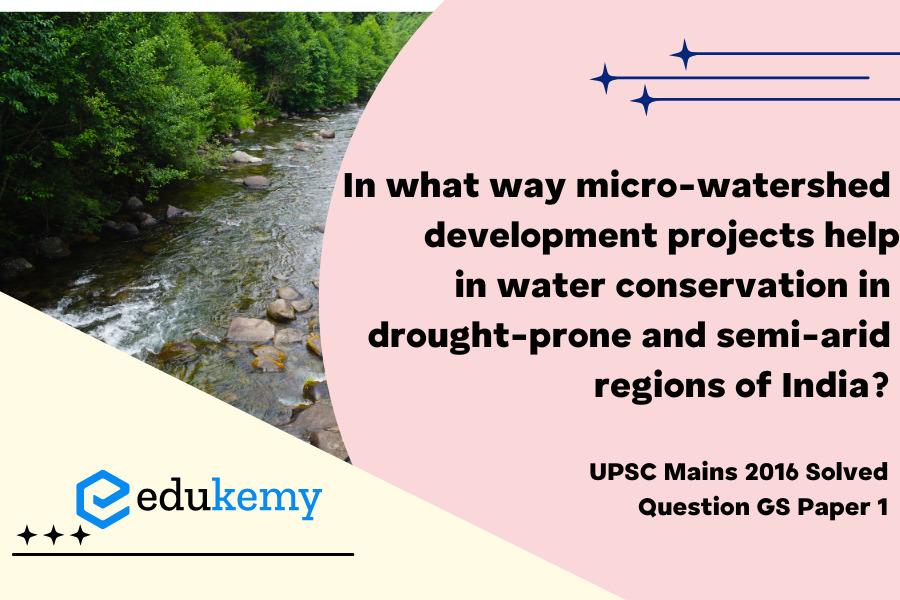Micro-watershed development projects play a pivotal role in addressing the water scarcity challenges prevalent in drought-prone and semi-arid regions of India. These projects are designed to focus on small-scale geographical areas, known as micro-watersheds, aiming to holistically manage and conserve water resources. In these arid landscapes, characterized by erratic rainfall patterns and frequent droughts, micro-watershed development becomes a strategic approach to enhance water availability and sustain agricultural livelihoods.
Tag: Distribution of key natural resources across the world (including South Asia and the Indian sub-continent).
Contents
Decoding the Question:
- In Introduction, you can write some facts about drought and semi-arid regions and why a micro-watershed development program is required.
- In Body, elaborate how micro-watershed development projects help in water conservation in drought-prone and semi-arid regions of India.
- Conclude with how more efforts and steps are required in micro-watershed development programmes.
Answer:
A watershed is a geo-hydrological unit, which drains into a common point. Watershed management is a comprehensive programme to maximise land and water utilisation available in the region. Micro-watershed development projects involve regional planning at village and other micro levels to manage and improve water use efficiency that indirectly enhances agricultural productivity and income of rural households. Drought-prone and semi-arid regions of India involve states like Rajasthan, Gujarat, Punjab, Haryana, AP, Karnataka, and Maharashtra. 11.8% of the country is under drought-prone and semi-arid regions.
Ways in which such development projects help conserve water are:
- Rainwater Harvesting: Micro-watershed development projects focus on capturing and storing rainwater, which is essential for water conservation in drought-prone areas. For example, in the state of Maharashtra, the government’s Jalyukt Shivar Abhiyan has constructed more than 5.5 lakh (550,000) water conservation structures like farm ponds, check dams, and percolation tanks, contributing to increased water availability during dry periods.
- Soil and Moisture Conservation: These projects implement soil and moisture conservation techniques like contour bunding, terracing, and mulching to prevent soil erosion and retain moisture in the soil. For instance, the Watershed Development Program in India has treated over 36 million hectares of land through soil and moisture conservation measures, contributing to better water retention and reduced runoff.
- Groundwater Recharge: Micro-watershed development projects focus on recharging groundwater sources, which are crucial for water availability during droughts. In the state of Gujarat, the Sujalam Sufalam Jal Sanchay Abhiyan aims to recharge groundwater by desilting and deepening water bodies, and it has resulted in the recharge of 22.5 billion litres of groundwater in one year.
- Drought-Resistant Farming Practices: Micro-watershed projects promote drought-resistant farming practices to conserve water in agriculture. For example, in Madhya Pradesh, the Watershed Development Program has encouraged the adoption of water-efficient farming practices, resulting in increased crop productivity by 35% and reduced water usage by 30-35%.
- Afforestation and Vegetation: Planting trees and vegetation is crucial for water conservation in drought-prone regions. In the state of Rajasthan, the Rajasthan Watershed Development and Soil Conservation Project has afforested 34,400 hectares of land, leading to increased water availability and improved ecological balance.
- Community Participation and Awareness: Micro-watershed projects involve local communities in water conservation efforts, creating a sense of ownership and responsibility. In the state of Karnataka, the Bhoochetana program, which promotes soil and water conservation practices, has covered more than 8.2 million hectares of land, involving farmers in the decision-making process.
- Water Management and Distribution: Micro-watershed projects implement water management systems to optimise water use. In Telangana, the Haritha Haram program has improved water management, resulting in increased water storage capacity of reservoirs by 19.39 tmc (thousand million cubic feet).
- Livelihood Diversification: Micro-watershed development projects encourage livelihood diversification to reduce dependency on agriculture during water scarcity. For example, in Odisha, the Mahatma Gandhi National Rural Employment Guarantee Scheme (MGNREGS) has provided alternative livelihood opportunities, benefiting more than 51 lakh households.
- Disaster Risk Reduction: By enhancing water conservation and groundwater recharge, micro-watershed projects contribute to disaster risk reduction in drought-prone regions. In Maharashtra, the Water Conservation Program has made over 11,000 villages drought-free through water conservation measures.
The use of the micro-watershed as the basic unit for planning and intervention was found to be useful, but the larger goals of protecting and conserving hydrologic services and/or managing negative downstream and groundwater impacts remained to be addressed as the micro-watershed approach was carried out in isolation. A micro project (at the sub-watershed level or micro-watershed level) needs to be planned for at least five to seven years in order to build sufficient social capital.
In case you still have your doubts, contact us on 9811333901.
For UPSC Prelims Resources, Click here
For Daily Updates and Study Material:
Join our Telegram Channel – Edukemy for IAS
- 1. Learn through Videos – here
- 2. Be Exam Ready by Practicing Daily MCQs – here
- 3. Daily Newsletter – Get all your Current Affairs Covered – here
- 4. Mains Answer Writing Practice – here


